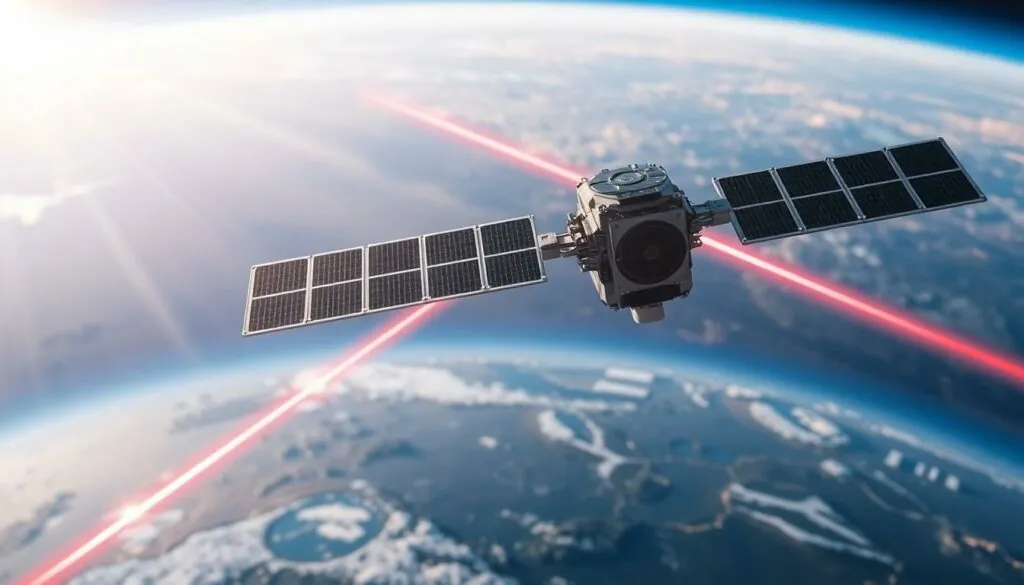Table of Contents
ToggleImagine a world where lasers aren’t just for sci-fi movies but are actually zipping around in space, ready to revolutionize everything from communication to defense. Space laser technology is no longer a figment of imagination; it’s a burgeoning field that promises to change the way we interact with the cosmos. With the ability to transmit data at lightning speed and even target threats from afar, these high-tech marvels could make us feel like we’re living in a futuristic utopia.
Overview of Space Laser Technology
Space laser technology encompasses advanced applications of lasers for communication and defense in the aerospace sector. Scientists and engineers develop these technologies to facilitate rapid data transmission over long distances. Laser beams can send large volumes of information faster than traditional radio frequencies, offering increases in efficiency and speed essential for modern operations.
Defense applications utilize laser systems for targeting and neutralizing threats. To enhance accuracy, these lasers can precisely focus on objects from vast distances. Countries are increasingly investing in this technology for improved capabilities in surveillance and missile defense systems.
Commercial use of space lasers is growing, as companies seek innovative solutions for satellite communications. A laser communication system might replace conventional microwave systems, reducing latency and expanding bandwidth. Specific projects, such as NASA’s Laser Communications Relay Demonstration, illustrate the potential for high-data-rate laser communications.
Research into atmospheric conditions continues, as weather can significantly impact laser performance. Understanding how factors like clouds or precipitation affect signal transmission helps engineers design more reliable systems. As technology matures, mitigating these challenges becomes crucial for expanding the feasibility of laser-based communications.
International collaborations are emerging in the field of space laser technology. By working together, nations can share knowledge and resources, fostering the development of better defense strategies and communication networks. Increased cooperation could lead to standardization across various laser systems, promoting interoperability between different nations’ technologies.
Space laser technology represents a revolutionary shift in how entities communicate and safeguard interests beyond Earth. As advancements continue, the transformative impact of lasers in both commercial and defense sectors will likely become increasingly evident.
Applications of Space Laser Technology

Space laser technology offers innovative applications across various fields, enhancing communication, observation, and exploration efforts.
Communication Systems
Laser technology significantly improves satellite communication systems. It allows for faster data transmission rates compared to traditional microwave methods. For instance, laser beams transmit large amounts of information in a fraction of the time. NASA’s Laser Communications Relay Demonstration proves the ability to achieve high-data-rate communication, overcoming traditional limitations. Enhanced bandwidth reduces latency, which benefits users requiring immediate data access. Countries increasingly invest in these systems for their efficiency, likely leading to a global shift in satellite communication practices.
Earth Observation
Earth observation benefits greatly from advancements in space laser technology. Laser systems facilitate precise measurements of atmospheric conditions and surface features. The use of Light Detection and Ranging (LiDAR) helps produce high-resolution maps, providing critical data for climate research and urban planning. Additionally, satellite-based laser observations contribute to monitoring changes in vegetation and topography. Accurate Earth monitoring allows for timely responses to environmental challenges, improving resource management efforts for governments and organizations.
Space Exploration
Space exploration leverages space laser technology to enhance mission capabilities. Laser systems assist in navigating spacecraft with greater accuracy, allowing for efficient trajectory adjustments. Communication between space vehicles relies on laser technology to transmit data back to Earth. This fast transfer speeds up the analysis of scientific information gathered during missions. Moreover, the potential for laser propulsion systems presents innovative opportunities for interplanetary travel, significantly shortening travel times. As research continues, space laser technology will likely revolutionize how humanity explores the cosmos.
Advantages of Space Laser Technology
Space laser technology offers significant benefits in communication and defense sectors. Its unique characteristics facilitate groundbreaking advancements.
Increased Data Transfer Rates
Laser beams transmit information at speeds surpassing traditional radio frequencies. Enhanced transmission capabilities allow for high-data-rate connections. With the potential to achieve gigabit speeds, data can be sent with minimal delay. Projects like NASA’s Laser Communications Relay Demonstration confirm these high-speed capabilities, making them viable for satellite communications. Reduced latency becomes a reality, improving overall system responsiveness. As a result, industries can leverage these advancements for applications requiring rapid data relay.
Enhanced Accuracy and Precision
Laser technology provides elevated levels of accuracy in targeting and data measurement. Systems employing lasers deliver precise readings critical for applications like Earth observation. LiDAR technology showcases how lasers can produce detailed topographical maps and climate data. Enhanced targeting systems in defense ensure threats are engaged with minimal collateral damage. Reliability in measurements supports strategic decision-making in various sectors. Increased accuracy fosters confidence in missions where precision is paramount.
Challenges Facing Space Laser Technology
Space laser technology faces significant challenges that could impact its development and implementation. Technical limitations impede efficiency while regulatory hurdles complicate operational deployment.
Technical Limitations
Technical limitations pose serious barriers in utilizing space laser systems effectively. Atmospheric interference disrupts laser signals, causing disruptions during transmission, especially in adverse weather conditions. Limited power output affects the range and effectiveness of lasers, hindering their ability to perform over vast distances. Additionally, current infrastructure may not support necessary advancements in laser technology, necessitating upgrades or replacements for existing systems. Performance variability can emerge from different environmental factors, necessitating ongoing research to optimize reliability.
Regulatory Hurdles
Regulatory hurdles create obstacles for the advancement of space laser technology. Complex international laws govern the use of lasers in space, restricting experiments and operational deployments. National security concerns complicate collaboration between countries, often resulting in fragmented development. Compliance with safety standards requires extensive testing and validation before deployment, adding time and cost to projects. Licensing agreements and frequency allocation further complicate the regulatory landscape, requiring coordination across multiple agencies. Understanding and addressing these regulations is crucial for the successful integration of laser technology in space operations.
Future Prospects of Space Laser Technology
Space laser technology continues to evolve, promising significant advancements across various sectors. Industries anticipate further innovations that enhance communication, navigation, and observation capabilities.
Emerging Innovations
Innovative developments in space laser technology are gaining momentum. Researchers explore advanced solid-state lasers, pushing the boundaries of data transmission. Laser communication systems are evolving to adapt to environmental challenges, ensuring more reliable connections. These innovations facilitate real-time data sharing with reduced latency and increased bandwidth. Companies are also focusing on integrating laser systems into satellites, optimizing performance and efficiency. Furthermore, concepts like laser propulsion are under investigation, potentially enabling faster interplanetary travel and greater exploration capabilities.
Potential Collaborations
Collaborative efforts between nations are essential for advancing space laser technology. Countries share expertise and resources, fostering innovation and accelerating development. Collaborative projects, such as joint research initiatives, focus on overcoming technical barriers and regulatory challenges. International partnerships can streamline the establishment of standardized systems, enhancing interoperability across various platforms. Additionally, collaborations extend to private sector engagement, where companies and governments unite to explore commercial applications. Together, these partnerships create a robust ecosystem that drives technological progress and addresses obstacles in the deployment of space laser systems.
Space laser technology is poised to redefine how humanity interacts with the cosmos. Its applications in communication and defense promise enhanced efficiency and precision, paving the way for a more interconnected and secure future. As advancements continue to emerge, the potential for innovative uses across various fields will only expand.
The collaborative efforts among nations and private entities will play a critical role in overcoming existing challenges. By addressing technical and regulatory hurdles, the industry can ensure that the benefits of space laser technology are fully realized. This transformative technology is not just a trend but a vital component of future exploration and communication strategies.





